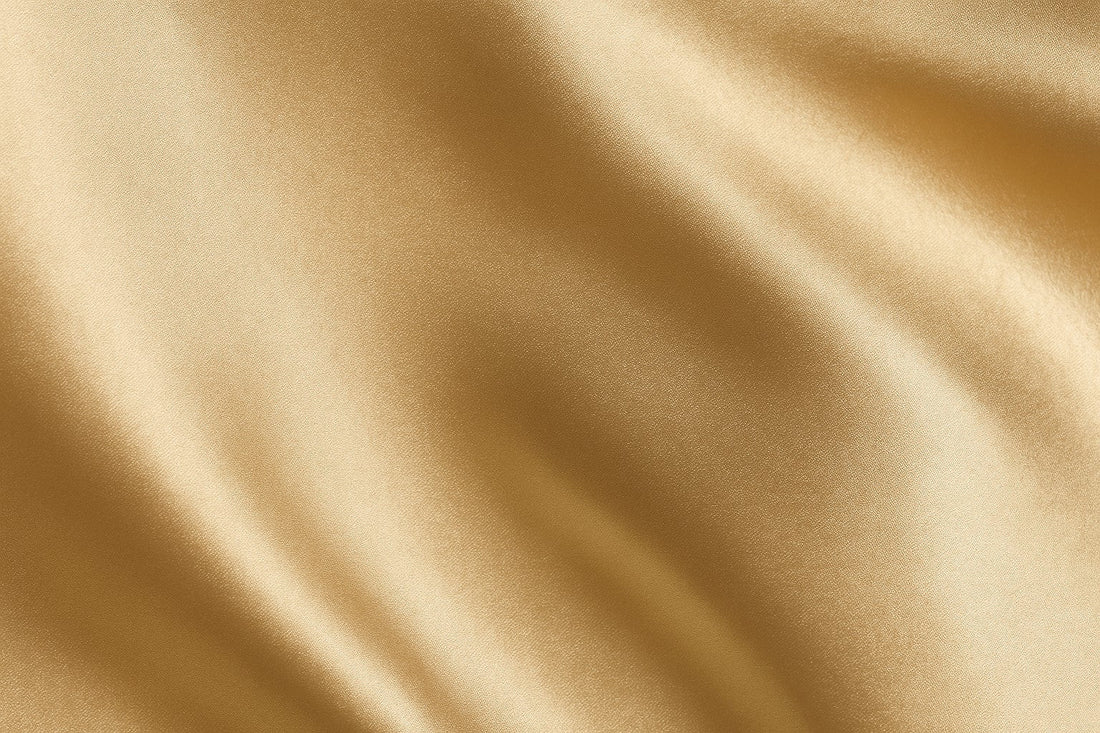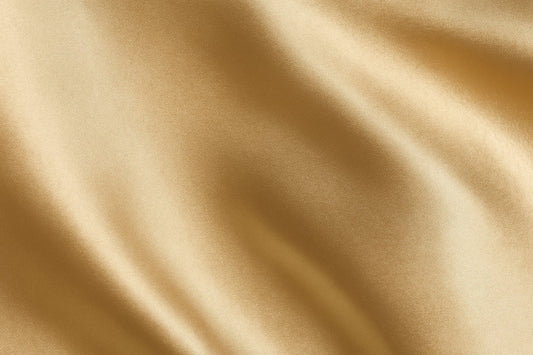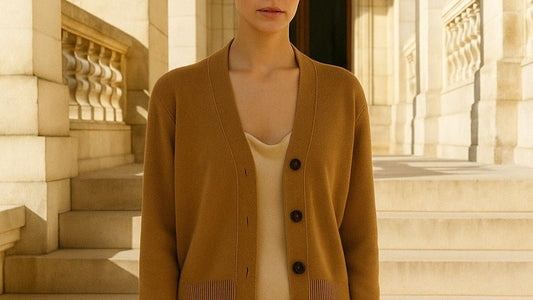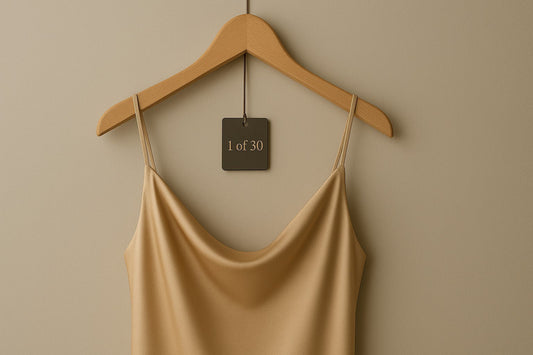
How to Tell if a Silk Dress Is Real or Synthetic: The Definitive Guide
You've found the perfect slip dress online. The product description promises "luxurious silk," the price seems reasonable, and the photos look gorgeous. But when it arrives, something feels off. The fabric doesn't drape quite right, it lacks that signature cool-to-the-touch sensation, and you're left wondering: is this real silk or an imposter?
With the proliferation of synthetic fabrics that mimic silk's appearance, distinguishing authentic silk from polyester satin or other look-alikes has become increasingly challenging. Even experienced fashion enthusiasts can struggle to identify genuine silk, especially when shopping online where you can't physically examine the fabric.
In this comprehensive guide, we'll walk you through proven methods to identify real silk, explain why quality matters (particularly in luxury garments), and help you make informed decisions when investing in silk pieces. Whether you're evaluating a potential purchase or examining a dress already in your wardrobe, these techniques will give you confidence in spotting the real deal.
Why It's So Difficult to Spot Fake Silk
Modern textile manufacturing has become remarkably sophisticated. High-quality polyester satin can closely mimic silk's lustrous appearance, and charmeuse-weave synthetics can even approximate that characteristic drape. This makes visual identification alone increasingly unreliable.
Several factors contribute to the confusion:
Marketing language: Terms like "silk satin," "silky," or "silk-like" are intentionally misleading. Some retailers describe polyester as "vegan silk" or use phrases that imply luxury without technically claiming the fabric is real silk.
Photography limitations: Online product photos, especially when professionally lit and edited, make it nearly impossible to distinguish fabric composition. That glossy sheen could be genuine silk charmeuse or could be polyester reflecting studio lights.
Price ambiguity: While genuine silk is typically expensive, price alone isn't always reliable. Synthetic "silk" dresses can be overpriced to suggest luxury, while legitimate silk pieces during sales might seem suspiciously affordable.
Blended fabrics: Some garments contain silk blends (perhaps 30% silk, 70% polyester), allowing brands to legally label them as containing silk while the feel and performance lean heavily synthetic.
The good news? Once you know what to look for, real silk reveals itself through several distinctive characteristics that synthetics simply cannot replicate.
The Touch Test: Your First Line of Defense
Before any other examination, trust your hands. Real silk has a unique tactile signature that experienced silk wearers recognize immediately.
Temperature Response
Real silk: When you first touch genuine silk, it feels cool against your skin—almost refreshingly so. This is because silk has excellent thermal regulation properties. As you hold it, the fabric gradually warms to your body temperature, then maintains that comfortable warmth. If you remove your hand and return it, the silk will have cooled again slightly.
Synthetic silk: Polyester and other synthetics tend to feel room temperature or slightly warm initially. They don't have silk's cooling sensation, and they heat up quickly when held, sometimes feeling clammy or creating a slight static charge.
Texture and Hand Feel
Real silk: The surface feels smooth but not slippery. There's a subtle catch or grip to it—a very slight texture that comes from the natural protein fibers. When you run your hand across quality silk, you might notice it sounds slightly different in each direction (a soft whisper or rustle).
Synthetic silk: Often feels either too slippery (overly slick, like it might slide right out of your hands) or slightly plastic-like. There's typically no directional sound variation, and the smoothness feels uniform rather than having silk's subtle irregularity.
The Scrunch Test
Take a handful of the fabric and scrunch it firmly in your fist for about 5 seconds, then release.
Real silk: Springs back immediately with minimal wrinkling. While silk will wrinkle if left bunched for long periods, momentary compression barely affects it. The fabric seems almost alive in how it recovers its shape.
Synthetic silk: Often emerges from the scrunch test with pronounced creases that take longer to fall out. Some polyester satins resist wrinkling well, but the recovery movement looks mechanical rather than fluid.
The Visual Inspection: Look Closer
While photos can deceive, examining fabric in person reveals telling details.
Luster and Shine Quality
This is where many people get tripped up, because both real and synthetic silk can be shiny. The difference lies in the quality and depth of that shine.
Real silk: Has a complex, multidimensional luster that shifts as you move the fabric. The shine has depth—it seems to come from within the fabric rather than sitting on the surface. In different lighting, silk reveals subtle color variations and a kind of soft glow. This is called "silk's natural sheen," created by the triangular prism-like structure of silk fibers refracting light.
Synthetic silk: Typically has a flat, uniform shine that looks more like a coating. The reflectivity is consistent across the fabric and doesn't have that complex, shifting quality. Under harsh lighting, cheap polyester satin can look almost plasticky with its unvarying gleam.
A helpful comparison: think of real silk's luster as candlelight—warm, complex, subtly shifting. Synthetic shine is more like a flashlight—bright, consistent, but lacking nuance.
Weave Irregularities
Natural silk, being made from silkworm cocoons, has very subtle irregularities that are actually signs of authenticity.
Real silk: Look closely (a magnifying glass helps) and you might see tiny slubs—slight variations in fiber thickness—or very minor inconsistencies in the weave. These aren't flaws; they're proof of natural origin. Even the highest-grade silk has microscopic variation.
Synthetic silk: The weave is usually perfectly uniform. Each fiber is exactly the same diameter, creating mechanical precision. While this might seem like a quality marker, it's actually evidence of synthetic production.
Drape and Movement
Hold the fabric up and watch how it moves.
Real silk: Falls in soft, organic folds with a liquid quality. When you move silk, it seems to flow like water—there's a natural weight and momentum to it. The fabric creates curves and undulations rather than rigid lines.
Synthetic silk: Often falls in stiffer, more geometric folds. The movement can look slightly wooden or artificial. Some polyester satins are too limp and collapse without structure, while others are too rigid and hold unwanted creases.
The Burn Test: The Most Reliable Method (Use with Caution)
The burn test is considered the gold standard for identifying real silk, but it requires destroying a small piece of fabric and should only be done safely and as a last resort.
How to Perform the Burn Test
- Take a tiny sample: Cut a few threads from an inner seam or hem allowance where it won't be visible (never burn the main fabric).
- Safety first: Work in a well-ventilated area, away from flammable materials. Have water nearby. Use tweezers to hold the threads, never your fingers.
- Apply flame: Hold the threads to a lighter or match flame briefly.
- Observe carefully: Note the smell, the way it burns, and what's left behind.
Real Silk Results
- Burns slowly and tends to curl away from flame
- Smells like burning hair or feathers (that distinctive protein smell)
- Self-extinguishes when you remove the flame—it doesn't continue burning
- Leaves dark, crispy ash that crushes easily into fine powder between your fingers
- No melting—silk chars and burns but doesn't melt into beads
Synthetic Silk Results
- Burns quickly with possible melting
- Smells chemical or like burning plastic (acrid, harsh odor)
- May continue burning after flame is removed
- Leaves hard, black beads that can't be crushed—these are melted plastic residue
- Obvious melting behavior as the synthetic fibers liquify
Important caveats: The burn test is destructive and can be dangerous if not done properly. It also won't work for blended fabrics (you'll get mixed results). If you're testing an expensive piece you don't own yet, sellers rarely allow this test, making it more useful for verification after purchase.
The Ring Test: Ancient Wisdom
This traditional test has been used for centuries in silk-trading cultures, though it's more about demonstrating silk's qualities than definitively proving authenticity.
Take a ring (a wedding band works well) and try to pull the fabric through it.
Real silk: Particularly lighter-weight silk like habutai or thin charmeuse can be pulled through a ring with some effort. This demonstrates silk's incredible strength-to-weight ratio and fine fiber diameter.
Synthetic silk: Depending on the weave, some polyester might also pass through a ring, so this test alone isn't conclusive. However, the ease and smoothness with which genuine silk slides through can feel different from synthetics.
This test is more useful for scarves or lighter garments. Heavy silk satin (like 25 momme charmeuse) won't easily fit through a ring, but that's not an indication of inauthenticity—it's simply too substantial.
Understanding Momme Weight: Why 25mm Mulberry Silk Lasts Longer
When shopping for real silk, you'll often see reference to "momme" (abbreviated as mm or momme), which is the standard measurement of silk weight and density. Understanding momme helps you assess quality even among genuine silk options.
What Is Momme?
Momme (pronounced "mummy") is a traditional Japanese unit measuring the weight of silk. Specifically, it's the weight in pounds of a piece of silk measuring 45 inches wide by 100 yards long. Higher momme numbers indicate heavier, denser silk.
Common momme weights:
- 12-16mm: Lightweight silk (scarves, light linings)
- 19-22mm: Medium weight (shirts, standard slip dresses)
- 25-30mm: Heavy luxury silk (premium slip dresses, high-end bedding

Why 25 Momme Matters for Luxury Garments
For silk slip dresses and evening wear, 25 momme represents the sweet spot between luxury weight and wearability.
Superior durability: The denser weave means more silk fibers per square inch, creating fabric that's more resistant to tears, snags, and general wear. A 25mm silk dress can last decades with proper care, while lighter 16mm silk might show wear within a few years.
Better drape: Heavier silk has more substantial drape—that coveted liquid quality that makes bias-cut slip dresses so flattering. The weight helps the fabric skim over the body in precisely the right way.
Improved opacity: One common complaint about lighter silk is sheerness. At 25 momme, pure silk charmeuse provides better coverage without requiring a lining, offering confidence and versatility.
Enhanced luster: Denser silk reflects light more beautifully. The multiple layers of triangular fibers create richer, more complex shimmer—that signature silk glow that catches light from every angle.
Temperature regulation: While all silk regulates temperature well, heavier silk provides more insulation in cool environments while still remaining breathable in warmth. This makes 25mm silk ideal for year-round wear.
Mulberry Silk vs. Other Types
Not all silk is created equal. The term "mulberry silk" specifically refers to silk produced by Bombyx mori silkworms that feed exclusively on mulberry leaves. This produces the highest quality silk with the longest, most uniform fibers.
Mulberry silk characteristics:
- Softer and more lustrous than other silk types
- More durable due to longer continuous fibers
- Smoother surface with fewer slubs
- Natural white or cream color (easier to dye consistently)
Other silk types (Tussah, Eri, Muga) come from wild silkworms and have shorter, less uniform fibers. While these can still be quality fabrics, they lack mulberry silk's supreme softness and durability.
When investing in luxury silk garments, look for "100% mulberry silk" in 22-25mm weight for optimal longevity and performance.
Pure Silk Satin in Made-to-Measure Luxury
The conversation about real versus synthetic silk becomes especially critical when investing in made-to-measure or bespoke garments. At this level of fashion, authenticity and quality aren't just preferences—they're fundamental expectations.
Why Material Matters in Custom Pieces
When you're commissioning a garment tailored specifically to your measurements, the fabric choice becomes paramount for several reasons:
Longevity: A made-to-measure piece represents both financial and emotional investment. You expect to wear it for years, possibly decades. Pure silk, particularly in higher momme weights, has the durability to justify that investment. Synthetic alternatives might look acceptable initially but deteriorate noticeably faster.
Fit precision: Pure silk's natural elasticity and drape behave consistently and predictably. When an atelier creates a bias-cut silk slip dress tailored to your body, they're calculating how that specific fabric will settle and move. Synthetic substitutes, with different stretch and recovery properties, won't fit as intended.
Aging gracefully: Real silk becomes softer and more lustrous with gentle wear, developing a beautiful patina. Polyester becomes more brittle, pills more easily, and loses its initial sheen, looking progressively cheaper over time.
Skin comfort: For garments worn against bare skin, the difference is profound. Pure silk is hypoallergenic, breathable, and naturally temperature-regulating. Synthetics can cause irritation, trap moisture, and feel clammy.
The Quiet Luxury Standard
In the realm of quiet luxury—where refinement comes from impeccable materials and craftsmanship rather than visible branding—fabric authenticity is non-negotiable. Discerning customers recognize that true luxury begins with honest, exceptional materials.
Contemporary luxury ateliers that specialize in minimalist, timeless pieces understand this implicitly. When creating limited-edition garments with clean lines and unfussy silhouettes, there's nowhere for inferior fabric to hide. Every quality—the drape, the luster, the hand feel—is immediately apparent.
This is why established made-to-measure houses exclusively source verified pure silk from reputable suppliers. The fabric's provenance is as important as the pattern-making and construction. Mulberry silk satin in 25 momme weight becomes not just a material choice but a statement of commitment to lasting quality.
Transparency in Sourcing
One advantage of working with smaller ateliers versus mass-market brands is transparency. Bespoke fashion houses can (and should) tell you exactly what you're getting: the silk's origin, its momme weight, its specific weave, and even its finishing process.
Questions to ask when investing in a made-to-measure silk piece:
- Is this 100% mulberry silk or a blend?
- What is the momme weight?
- Where is the silk sourced and woven?
- What finishing treatments have been applied (if any)?
- How should I care for this specific silk?
Reputable makers will answer these questions enthusiastically. Evasiveness or vague responses like "luxury silk blend" should raise red flags.
Red Flags: When to Be Skeptical
Certain warning signs suggest a garment might not be genuine silk:
Price too good to be true: While sales happen, if you see a "pure silk" slip dress for under $100, be very skeptical. Quality silk fabric alone costs significant money before construction even begins.
Washing instructions: If the care label says "machine wash warm" or "tumble dry," it's likely synthetic. Real silk requires gentle hand washing or dry cleaning.
Vague material descriptions: Labels saying "silk satin" without specifying "100% silk" or "pure silk" are often polyester satin. Similarly, "silk charmeuse" without confirmation of fiber content might be synthetic charmeuse weave.
Too-perfect appearance: Genuine silk has subtle natural variation. If every inch looks identical with zero irregularities, it's probably synthetic.
Static electricity: If the fabric generates static cling or attracts lint, it's synthetic. Real silk doesn't create static.
Smell when new: Fresh silk has a subtle, slightly organic scent (not unpleasant, just natural). Synthetics often smell chemical or plasticky when new.
Making Smart Wardrobe Investments
Understanding how to identify real silk empowers you to make informed purchasing decisions. Here's how to apply this knowledge:
When Shopping Online
- Read fine print carefully: Look for explicit "100% silk" or "pure mulberry silk" statements
- Check return policies: Reputable sellers confident in their silk quality offer generous returns
- Research the brand: Look for reviews mentioning fabric quality specifically
- Ask questions: Contact customer service and ask direct questions about silk type, momme weight, and origin
- Be willing to pay fair prices: Genuine quality silk garments reflect their material and construction costs
When Shopping in Person
- Use the touch test immediately: That cool-to-touch sensation is your first clue
- Examine in multiple lighting: Take the garment to natural light if possible
- Check the care label: It should specify silk content percentage
- Assess the construction: Real silk deserves quality craftsmanship—check seams, hems, and finishing
- Compare with known silk: If possible, touch a piece you know is real silk first to calibrate your senses
Building a Luxury Wardrobe
When investing in pieces like a silk slip dress, consider the cost-per-wear calculation. A $1,400 genuine silk dress worn and cherished for 15 years costs less per wear than a $200 synthetic version replaced every two years—and provides immeasurably better experience.
Key investment principles:
Prioritize versatility: Choose colors and styles you'll wear repeatedly
Factor in timelessness: Classic silhouettes in real silk never go out of style
Consider care costs: Real silk requires more careful maintenance, but lasts far longer
Value exclusivity: Made-to-measure pieces in genuine silk offer uniqueness that ready-to-wear cannot match
Trust your instincts: If something feels off, it probably is—trust your touch test
The Verdict: Real Silk Is Worth Finding
In an age of sophisticated synthetics and misleading marketing, knowing how to identify genuine silk is an invaluable skill. While polyester satin serves its purpose in fast fashion, there's simply no substitute for real silk when you're investing in pieces meant to last.
The touch test, visual inspection, and understanding of momme weights will guide you toward authentic silk that performs beautifully for years. Whether examining a potential purchase or evaluating your current wardrobe, these methods ensure you know exactly what you're wearing.
For those drawn to quiet luxury and timeless elegance, genuine silk—particularly premium mulberry silk in higher momme weights—represents not just material quality but a commitment to lasting style. When that silk is crafted into a made-to-measure garment tailored precisely to your body, you achieve something rare in modern fashion: true exclusivity combined with enduring beauty.
The next time you hold a silk garment, you'll know within moments whether it's authentic. That cool touch, that complex luster, that liquid drape—real silk announces itself to those who know how to listen. And once you've experienced genuine silk's luxury against your skin, synthetics simply won't satisfy anymore.
Ready to experience the difference that genuine 25 momme mulberry silk makes? Explore made-to-measure options that combine authentic luxury fabrics with bespoke construction—because true elegance begins with uncompromising quality.








